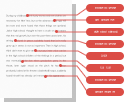《新GRE写作论证论据素材大全》行为类(一)
作者:韦晓亮 来源:极智批改网 2014-03-11
主要论证论据素材包括:动机的概念、动机的类型、动机和情感、动力的减弱、内在驱动和外在刺激、内在动机与内在驱动学生的三大特征、态度改变的影响因素、影响态度改变的四大因素、情感对行为的影响、情感和态度改变、情感诉求的组成、影响情感诉求的四大因素、行动理论、行为的回报和强化。
第二大类 行为类
1 动机的概念
Motivation is a word used to refer to the reason or reasons for engaging in a particular behavior,especially human behavior as studied in psychology and neuropsychology. These reasons mayinclude basic needs such as food or a desired object, goal, state of being, or ideal. The motivationfor a behavior may also be attributed to less-apparent reasons such as altruism or morality.Motivation refers to the initiation, direction, intensity and persistence of human behavior.
2 动机的类型
In knowledge-sharing communities and organizations, people often cite altruistic reasons for theirparticipation, including contributing to a common good, a moral obligation to the group,mentorship or “giving back”. In work environments, money may provide a more powerfulextrinsic factor than the intrinsic motivation provided by an enjoyable workplace.
The most obvious form of motivation is coercion, where the avoidance of pain or other negativeconsequences has an immediate effect. Extreme use of coercion is considered slavery. Whilecoercion is considered morally reprehensible in many philosophies, it is widely practiced onprisoners, students in mandatory schooling, within the nuclear family unit (on children), and inthe form of conscription. Critics of modern capitalism charge that without social safety networks,wage slavery is inevitable. However, many capitalists such as Ayn Rand have been very vocalagainst coercion. Successful coercion sometimes can take priority over other types of motivation.Self-coercion is rarely substantially negative (typically only negative in the sense that it avoids apositive, such as forgoing an expensive dinner or a period of relaxation), however, it is interestingin that it illustrates how lower levels of motivation may be sometimes tweaked to satisfy higherones.
3 动机和情感
Motivation is the driving force of desire behind all deliberate actions of human beings. Motivationis based on emotion—specifically, on the search for satisfaction(positive emotional experiences),and the avoidance of conflict. Positive and negative is defined by the individual brain state, whichmay be influenced by social norms: a person may be driven to self-injury or violence because theirbrain is conditioned to create a positive response to these actions. Motivation is important becauseit is involved in the performance of all learned responses.
Within psychology, conflict avoidance and the libido are seen to be primary motivators. Withineconomics motivation is often seen to be based on financial incentives, moral incentives, orcoercive incentives. Religions generally posit divine or demonic influences.
4 动力的减弱
There are a number of drive theories. The Drive Reduction Theory grows out of the concept thatwe have certain biological needs, such as hunger. As time passes, the strength of the driveincreases as it is not satisfied. Then as we satisfy that drive by fulfilling its desire, such as eating,the drive‟s strength is reduced. It is based on the theories of Freud and the idea of feedback controlsystems, such as a thermostat.
There are several problems, however, that leave the validity of the Drive Reduction Theory open for debate. The first problem is that it does not explain how Secondary Reinforcers reduce drive.For example, money does not satisfy any biological or psychological need but reduces drive on aregular basis through a pay check second-order conditioning. Secondly, if the drive reductiontheory held true we would not be able to explain how a hungry human being can prepare a mealwithout eating the food before they finished cooking it.However, when comparing this to a real life situation such as preparing food, one does gethungrier as the food is being made (drive increases), and after the food has been consumed thedrive decreases. The only reason the food does not get eaten before is the human element ofrestraint and has nothing to do with drive theory. Also, the food will either be nicer after it iscooked, or it won‟t be edible at all before it is cooked.
5 内在驱动和外在刺激
Drives and desires can be described as a deficiency or need that activates behavior that is aimed ata goal or an incentive. These are thought to originate within the individual and may not requireexternal stimuli to encourage the behavior. Basic drives could be sparked by deficiencies such ashunger, which motivates a person to seek food; whereas more subtle drives might be the desire forpraise and approval, which motivates a person to behave in a manner pleasing to others.
By contrast, the role of extrinsic rewards and stimuli can be seen in the example of traininganimals by giving them treats when they perform a trick correctly. The treat motivates the animalsto perform the trick consistently, even later when the treat is removed from the process.
6 内在动机与内在驱动学生的三大特征
Intrinsic motivation is the drive for which people engage in an activity, without obvious externalincentives, such as a hobby. Intrinsic motivation has been studied by educational psychologistssince the 1970s, and numerous studies have found it to be associated with high educationalachievement and enjoyment by students.
It is thought that students are more likely to be intrinsically motivated if they:
1. Attribute their educational results to internal factors that they can control (e.g. the amount ofeffort they put in).
2. Believe they can be effective agents in reaching desired goals (i.e. the results are notdetermined by dumb luck).
3. Are interested in mastering a topic, rather than just rote-learning to achieve good grades.
7 态度改变的影响因素
The inter-structural composition of an associative network can be altered by the activation of asingle node. Thus, by activating an affective or emotion node, attitude change may be possible,though affective and cognitive components tend to be intertwined. In primarily affective networks,it is more difficult to produce cognitive counterarguments in the resistance to persuasion andattitude change.
Affective forecasting, otherwise known as intuition or the prediction of emotion, also impactsattitude change. Research suggests that predicting emotions is an important component of decisionmaking, in addition to the cognitive processes. How we feel about an outcome may overridepurely cognitive rationales.
In terms of research methodology, the challenge for researchers is measuring emotion and subsequent impacts on attitude. Since we cannot see into the brain, various models andmeasurement tools have been constructed to obtain emotion and attitude information. Measuresmay include the use of physiological cues like facial expressions, vocal changes, and other bodyrate measures. For instance, fear is associated with raised eyebrows, increased heart rate andincreased body tension. Other methods include concept or network mapping, and using primes orword cues.
8 影响态度改变的四大因素
Attitudes can be changed through persuasion. We should understand attitude change as a responseto communication. Factors that can affect the persuasiveness of a message are:
1. Target Characteristics: These are characteristics that refer to the person who receives andprocesses a message. One such trait is intelligence—it seems that more intelligent people are lesseasily persuaded by one-sided messages. Another variable that has been studied in this category isself-esteem. Although it is sometimes thought that those higher in self-esteem are less easilypersuaded, there is some evidence that the relationship between self-esteem and persuasibility isactually curvilinear, with people of moderate self-esteem being more easily persuaded than boththose of high and low self-esteem levels. The mind frame and mood of the target also plays a rolein this process.
2. Source Characteristics: The major source characteristics are expertise, trustworthiness andinterpersonal attraction or attractiveness. The credibility of a perceived message has been found tobe a key variable here; if one reads a report about health and believes it comes from a professionalmedical journal, one may be more easily persuaded than if one believes it is from a popularnewspaper. Some psychologists have debated whether this is a long-lasting effect and the effect oftelling people that a message came from a credible source disappeared after several weeks (theso-called “sleeper effect”). Whether there is a sleeper effect is controversial. Received wisdom isthat if people are informed of the source of a message before hearing it, there is less likelihood ofa sleeper effect than if they are told a message and then told its source.
3. Message Characteristics: The nature of the message plays a role in persuasion. Sometimespresenting both sides of a story is useful to help change attitudes.
4. Cognitive Routes: A message can appeal to an individual‟s cognitive evaluation to helpchange an attitude. In the central route to persuasion the individual is presented with the data andmotivated to evaluate the data and arrive at an attitude changing conclusion. In the peripheralroute to attitude change, the individual is encouraged to not look at the content but at the source.This is commonly seen in modern advertisements that feature celebrities. In some cases, physician,doctors or experts are used. In other cases, film stars are used for their attractiveness.
9 情感对行为的影响
Human emotion has a significant influence on, or can even be said to control, human behavior,though historically many cultures and philosophers have for various reasons discouraged allowingthis influence to go unchecked.
In modern scientific thought, certain refined emotions are considered to be a complex neural traitof many domesticated and a few non-domesticated mammals. These were commonly developed inreaction to superior survival mechanisms and intelligent interaction with each other and theenvironment; as such, refined emotion is not in all cases as discrete and separate from natural neural function as was once assumed. Still, when humans function in civilized tandem, it has beennoted that uninhibited acting on extreme emotion can lead to social disorder and crime.
10 情感和态度改变
Emotion is a common component in persuasion, social influence, and attitude change. Much ofattitude research emphasized the importance of affective or emotion components. Emotion workshand-in-hand with the cognitive process, or the way we think, about an issue or situation.Emotional appeals are commonly found in advertising, health campaigns and political messages.Recent examples include no-smoking health campaigns and political campaign advertisingemphasizing the fear of terrorism.
Taking into consideration current attitude research, attitudes is defined as mental and neuralrepresentations, organized through experience, exerting a directive or dynamic influence onbehavior. Attitudes and attitude objects are functions of cognitive, affective and conativecomponents. Attitudes are part of the brain‟s associative networks, the spider-like structuresresiding in long term memory that consist of affective and cognitive nodes linked throughassociative pathways. These nodes contain affective, cognitive, and behavioral components.
11 情感诉求的组成
Any discrete emotion can be used in a persuasive appeal; this may include jealousy, disgust,indignation, fear, and anger. Fear is one of the most studied emotional appeals in communicationand social influence research. Fear appeals have been thought of as messages that attempt toachieve opinion change by establishing the negative consequences of failing to agree with theadvocated position.
Important consequences of fear appeals and other emotion appeals include the possibility ofreactance which may lead to either message rejections or source rejection and the absence ofattitude change. There is an optimal emotion level in motivating attitude change. If there is notenough motivation, an attitude will not change; if the emotional appeal is overdone, the motivationcan be paralyzed thereby preventing attitude change.
12 影响情感诉求的四大因素
Important factors that influence the impact emotion appeals include self-efficacy, attitudeaccessibility, issue involvement, and message/source features.
Self-efficacy is a perception of one‟s own human agency; in other words, it is the perception ofour own ability to deal with a situation. It is an important variable in emotion appeal messagesbecause it dictates a person‟s ability to deal with both the emotion and the situation. For example,if a person is not self-efficacious about their ability to impact the global environment, they are notlikely to change their attitude or behavior about global warming.
Message features such as source non-verbal communication, message content, and receiverdifferences can impact the emotion influence of fear appeals. The characteristics of a message areimportant because one message can elicit different levels of emotion for different people. Thus, interms of emotion appeals messages, one size does not fit all.
Attitude accessibility refers to the activation of an attitude from memory; in other words, howreadily available is an attitude about an object, issue, or situation. Issue involvement is the relevance and salience of an issue or situation to an individual. Issue involvement has been correlated with both attitude access and attitude strength. Past studiesconclude accessible attitudes are more resistant to change.
13 行动理论
Action theory concerned with theories about the processes causing intentional (willful) humanbodily movements of more or less complex kind.
Basic action theory typically describes action as behavior caused by an agent in a particularsituation. The agent‟s desires and beliefs(e.g. my wanting a glass of water and believing the clearliquid in the cup in front of me is water) lead to bodily behavior (e.g. reaching over for theglass). In the simple theory, the desire and belief jointly cause the action. We should take theconcept of intention as basic and not analyzable into beliefs and desires.
14 行为的回报和强化
A reward, tangible or intangible, is presented after the occurrence of an action (i.e. behavior)with the intent to cause the behavior to occur again. This is done by associating positive meaningto the behavior. Studies show that if the person receives the reward immediately, the effect wouldbe greater, and decreases as duration lengthens. Repetitive action-reward combination can causethe action to become habit.
Rewards can also be organized as extrinsic or intrinsic. Extrinsic rewards are external to theperson; for example, praise or money. Intrinsic rewards are internal to the person; for example,satisfaction or accomplishment.
Some authors distinguish between two forms of intrinsic motivation: one based on enjoyment, theother on obligation. In this context, obligation refers to motivation based on what an individualthinks ought to be done. For instance, a feeling of responsibility for a mission may lead to helpingothers beyond what is easily observable, rewarded, or fun.
A reinforcer is different from reward, in that reinforcement is intended to create a measuredincrease in the rate of a desirable behavior following the addition of something to theenvironment.
批改及润色体验馆 想知道您的作文、口语、文书将如何被我们的专家批改及润色吗? 查看更多
 马上体验口语批改
马上体验口语批改
 马上体验作文批改
马上体验作文批改
 马上体验文书润色
马上体验文书润色
作文题库:
托福-综合写作 托福-独立写作 雅思-小作文 雅思-大作文 GRE-Issue GRE-Argument GMAT-Argument SAT-Essay ACT-McGraw-Hill ACT-历年代表性作文题目考研-小作文 考研-大作文 四级-作文 六级-作文 专四-大作文 专四-小作文 专八-作文 高考-新课标一 高考-新课标二 高考-北京 高考-天津 高考-广东 高考-四川 高考-辽宁 高考-安徽 高考-福建 高考-湖南 高考-湖北 高考-陕西 高考-浙江 高考-山东 高考-上海 高考-重庆 高考-江苏 高考-江西 高考-杭州外国语学校 高考-郑州四中 高考-章丘
口语题库:
托福-Question 1 托福-Question 2 托福-Question 3 托福-Question 4 托福-Question 5 托福-Question 6 雅思-Part 1 雅思-Part 2 雅思-Part 3求职面试-500强企业高频通用英文面试题目100道 求职面试-各大企业常用场景英文面试题目
签证面签-你是谁 签证面签-你去做什么 签证面签-你有能力去做吗 签证面签-你会回来吗
留学面试-关于学校及专业 高考-高考口语
文书润色:
留学文书 学术论文 商务文书 求职文书 课程作业 书稿润色 学术论文试用 学术论文摘要文章推荐
- 《新GRE写作论证论据素材大全》艺术类(二)
- 《新GRE写作论证论据素材大全》艺术类(三)
- 《新GRE写作论证论据素材大全》艺术类(一)
- 《新GRE写作论证论据素材大全》文化类(三)
- 《新GRE写作论证论据素材大全》文化类(二)
- 《新GRE写作论证论据素材大全》文化类(一)
- 《新GRE写作论证论据素材大全》政治类(二)
- 《新GRE写作论证论据素材大全》政治类(一)
- 《新GRE写作论证论据素材大全》学习类(四)
- 《新GRE写作论证论据素材大全》学习类(三)
- 《新GRE写作论证论据素材大全》学习类(二)
- 《新GRE写作论证论据素材大全》学习类(一)
- GRE Argument 168 范文+逐段点评+全篇总评
- 《新GRE写作论证论据素材大全》科技类(三)
- GRE Argument 152 范文+逐段点评+全篇总评
- GRE Argument 160 范文+逐段点评+全篇总评
- 《新GRE写作论证论据素材大全》科技类(二)
- GRE Argument 135 范文+逐段点评+全篇总评
- GRE Issue 104 (107) 范文+逐段点评+全篇总评
- 《新GRE写作论证论据素材大全》科技类(一)
- GRE Argument 132 范文+逐段点评+全篇总评
- 《新GRE写作论证论据素材大全》教育类(三)
- GRE Issue 123 范文+逐段点评+全篇总评
- GRE Argument 142 范文+逐段点评+全篇总评
- 《新GRE写作论证论据素材大全》教育类(二)
- GRE Issue 143 范文+逐段点评+全篇总评
- GRE Argument 170 范文+逐段点评+全篇总评
- 新GRE写作论证论据素材大全》教育类(一)
- GRE Issue 114 范文+逐段点评+全篇总评
- 【GRE Argument 113 范文+逐段点评+全篇总评】
- 《新GRE写作论证论据素材大全》行为类(三)
- GRE Issue 101 范文+逐段点评+全篇总评
- GRE Argument 109-110 范文+逐段点评+全篇总评
- 《新GRE写作论证论据素材大全》行为类(二)
- GRE Issue 89 范文+逐段点评+全篇总评
- GRE Argument 101 范文+逐段点评+全篇总评
- 《新GRE写作论证论据素材大全》行为类(一)
- 《新GRE写作论证论据素材大全》社会发展类三
- 《新GRE写作论证论据素材大全》社会发展类二
- GRE Argument10范文+逐段点评+全篇总评
- GRE Issue8范文+逐段点评+全篇总评
- GRE Issue13范文+逐段点评+全篇总评
- GRE Argument8范文+逐段点评+全篇总评
- GRE Issue7范文+逐段点评+全篇总评
- GRE Issue4范文+逐段点评+全篇总评

使用有问题?请联系我们的在线专家
工作时间:09:00AM - 08:00PM
 专家在线
专家在线





